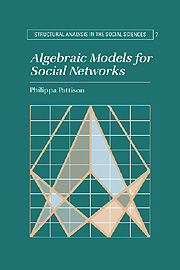Book contents
- Frontmatter
- Contents
- List of figures and tables
- Preface
- 1 Algebraic representations for complete social networks
- 2 Algebraic representations for local social networks
- 3 Comparing algebraic representations
- 4 Decompositions of network algebras
- 5 An analysis for complete and local networks
- 6 Time-dependent social networks
- 7 Algebras for valued networks
- 8 Issues in network analysis
- References
- Appendix A Some basic mathematical terms
- Appendix B Proofs of theorems
- Author index
- Subject index
5 - An analysis for complete and local networks
Published online by Cambridge University Press: 21 October 2009
- Frontmatter
- Contents
- List of figures and tables
- Preface
- 1 Algebraic representations for complete social networks
- 2 Algebraic representations for local social networks
- 3 Comparing algebraic representations
- 4 Decompositions of network algebras
- 5 An analysis for complete and local networks
- 6 Time-dependent social networks
- 7 Algebras for valued networks
- 8 Issues in network analysis
- References
- Appendix A Some basic mathematical terms
- Appendix B Proofs of theorems
- Author index
- Subject index
Summary
In chapter 4, a method for analysing the algebra of a complete or local network into simple components was described. In this chapter we develop a means for relating that analysis of the algebraic representation of a network to decompositions at the relational or network level. In particular, we explore the question of whether each component, or factor, of the algebraic representation corresponds to any component of the associated network.
The importance of such a question is both mathematical and substantive. Not only is it relevant to a more complete mathematical understanding of the relationship between a network and the algebra that it defines (and hence of the theoretical value of the representation), but it also plays a significant interpretative role. More specifically, it enables us to determine whether each algebraic component has concrete relational referents and, if so, to identify them explicitly. These referents, if they exist, provide data for the assessment of the representation in terms of the original network data and so provide useful complementary evidence for the value, or otherwise, of the representation.
In particular, the factorisation procedure decomposes the algebra of a network into isotone homomorphic images in the case of partially ordered semigroups, or nested role algebras in the case of local role algebras. In each case, the components of the factorisation are “simpler” algebraic representations than the algebra of the network, in the sense of making fewer distinctions among labelled paths in the corresponding network.
- Type
- Chapter
- Information
- Algebraic Models for Social Networks , pp. 172 - 223Publisher: Cambridge University PressPrint publication year: 1993



